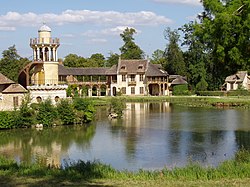
The Hameau de la Reine (French pronunciation: [amo də la ʁɛn], The Queen's Hamlet) is a rustic retreat in the park of the Château de Versailles built for Marie Antoinette in 1783 near the Petit Trianon in Yvelines, France. It served as a private meeting place for the queen and her closest friends and as a place of leisure. Designed by Richard Mique, the queen's favoured architect, with the help of the painter Hubert Robert, it contained a meadowland with a lake and various buildings in a rustic or vernacular style, inspired by Norman or Flemish design, situated around an irregular pond fed by a stream that turned a mill wheel.[1] The building scheme included a farmhouse, (the farm was to produce milk and eggs for the queen), a dairy, a dovecote, a boudoir, a barn that burned down during the French Revolution, a mill and a tower in the form of a lighthouse. Each building is decorated with a garden, an orchard or a flower garden. The largest and most famous of these houses is the "Queen's House", connected to the Billiard house by a wooden gallery, at the center of the village. A working farm was close to the idyllic, fantasy-like setting of the Queen's Hamlet.
The hameau is the best-known of a series of rustic garden constructions built at the time, notably the Prince of Condé's Hameau de Chantilly (1774–1775) which was the inspiration for the Versailles hamlet.[2] Such model farms, operating under principles espoused by the Physiocrats, were fashionable among the French aristocracy at the time. One primary purpose of the hameau was to add to the ambiance of the Petit Trianon, giving the illusion that it was deep in the countryside rather than within the confines of Versailles. The rooms at the hameau allowed for more intimacy than the grand salons at Versailles or at the Petit Trianon.


Abandoned after the French Revolution, it was first renovated under Napoleon I, then in the 1930s and again in late 1990. Buildings are still being periodically renovated to this day. Currently, it is open to the public.
- ^ Hunt, John Dixon (2002). The Picturesque Garden in Europe. London: Thames & Hudson. p. 130. ISBN 0-500-51085-7.
- ^ "Le Hameau" ["The Hamlet"]. Chateau de Versailles. N.p., n.d.